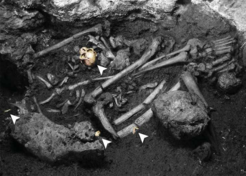From Food to Grave Good: Exploitation of Monkeys in Java, Indonesia From ca. 10,000 Years Ago
In a new study published in Current Anthropology, a team of researchers from the French National Museum of Natural History, the Indonesian Center for Archaeological Research and the Department of Archaeology, MPI-SHH, describes the complex human-non-human primate interactions in Java, Indonesia from around 10,000 to 5000 years ago. The research shows that in addition to exploitation as the primary protein source and use as a source of materials for tool and ornament production, monkeys played a role in the rituals of early hunter-gatherer societies in the island, as demonstrated by a roughly 8,500-year-old human burial with associated monkey remains.

The researchers studied the faunal remains from two cave sites in Eastern Java: Song Terus and Braholo Cave. The Holocene faunal assemblages of both sites are characterized by animals adapted to dense rainforests, including arboreal rodents, tree-dwelling squirrels, and understory-dependent bats and gliders, among other generalist taxa such as deer, civet cat, rhinoceros and elephant. Interestingly, around 60 percent of the animal remains recovered from the Holocene sediment layers of both sites were from monkeys.
The hunter gatherer communities that settled the sites did not settle for any monkeys; they selectively targeted the ebony leaf monkey (Tracypitheus auratus) over long-tailed macaques (Macaca fascicularis) and surilis (Presbytis comata). Because the ebony leaf monkey is a strictly arboreal species (i.e. they rarely venture to the ground), the researchers argue that they were most likely hunted using projectile technology. Detailed recording of the placement of butchery marks and patterns of bones fragmentation allowed the researchers to reconstruct how monkey carcasses were processed. They showed that entire monkey carcasses were brought to the cave sites and processed in a careful and considered sequence that involved skinning and evisceration. The considered way by which monkey carcasses were processed suggests that the people that lived in the Song Terus and Braholo Cave had intimate knowledge of the anatomy of the monkeys that they hunted. The researchers also observed differences in butchery patterns between leaf monkeys and macaques, which they interpreted as evidence that the people that inhabited the sites discriminated between the two species.
In addition to being consumed for food, monkeys were also utilized as source of raw materials for tool and ornament production. Finished tools including needles, points and spatulas and numerous unfinished blanks made from monkey skeletal elements were recovered in both sites. Monkey canines fashioned as pendants were also found. In Song Terus, several monkey skull and mandible fragments were found associated with a human burial dated to ca. 8500 BP, suggesting symbolic or ritualistic significance of monkeys in the early Holocene of the region.
